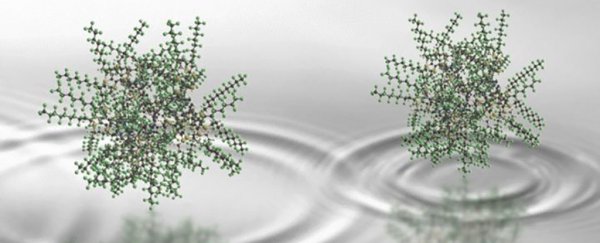You might be familiar with the Schrödinger's cat thought experiment, where the eponymous feline in a box can be both alive or dead at the same time, often used to illustrate the multi-state paradox of quantum mechanics.
Well, now scientists have managed to apply that theory to huge molecules made up of 2,000 atoms.
Quantum superposition has been tested countless times on smaller systems, with physicists successfully showing that individual particles can be in two places at one time. But this type of experiment hasn't been carried out at this scale before.
What the experiment does is allow scientists to refine the hypotheses of quantum mechanics and understand more about how this particularly mind-bending branch of physics actually works – and how the laws of quantum mechanics join up with the more traditional, larger scale, classical laws of physics.
"Our results show excellent agreement with quantum theory and cannot be explained classically," state the researchers in their published paper.
In particular, the new study involves the Schrödinger equation (yes, him again), which describes how even single particles can also act as waves in multiple places at once, interfering with each other just like ripples on a pond.
To test this, the scientists set up a double-slit experiment - an experiment that's very familiar to quantum physicists.
Traditionally, it involves projecting individual particles of lights (photons) through two slits. If the photons acted simply as particles, the resulting projection of light on the other side would simply show one band. But in reality, the light projected on the other side shows an interference pattern - multiple bands that interact, showing that light particles can also act as waves.
 (Johannes Kalliauer/Wikimedia, CC-BY-SA 3.0)
(Johannes Kalliauer/Wikimedia, CC-BY-SA 3.0)
It effectively seem as if the photons are in two places at once, just like Schrödinger's cat. But as most of us are aware, the cat is only in two states while it remains unobserved. As soon as the box is open, it's either confirmed as being alive or dead, not both.
It's the same with photons. As soon as the light is measured or observed directly, this superposition disappears and the state of the photon is locked in. This is one of the conundrums at the heart of quantum mechanics.
This same double-slit experiment has been done with electrons, atoms, and smaller molecules. And now physicists show it applies to massive molecules, too.
In this take on the double-slit experiment, the team was able to use these heavy molecules, made up of as many as 2,000 atoms, to create quantum interference patterns, as if they were behaving as waves and being in more than one place.
The molecules were known as "oligo-tetraphenylporphyrins enriched with fluoroalkylsulfanyl chains", and some were more than 25,000 times the mass of a hydrogen atom.
But as molecules get bigger, they also get less stable, and the scientists were only able to get them interfering for seven milliseconds at a time, using a newly designed piece of equipment called a matter-wave interferometer (designed to measure atoms along different paths).
Even factors like the Earth's rotation and gravitational pull had to be factored in. It was worth the effort though – we now know these giant molecules can be in two places at once, as well as much smaller atoms.
As quantum mechanics traditionally comes into play on very small scales, and classical physics on larger scales, the bigger the molecules we can get working with the double slit experiment, the closer we get to that quantum-classical boundary line. A previous record for this kind of study involved molecules up to 800 atoms in size.
"Our experiments show that quantum mechanics, with all its weirdness, is also amazingly robust, and I'm optimistic that future experiments will test it on an even more massive scale," says physicist Yaakov Fein, from the University of Vienna in Austria.
The research has been published in Nature Physics.
